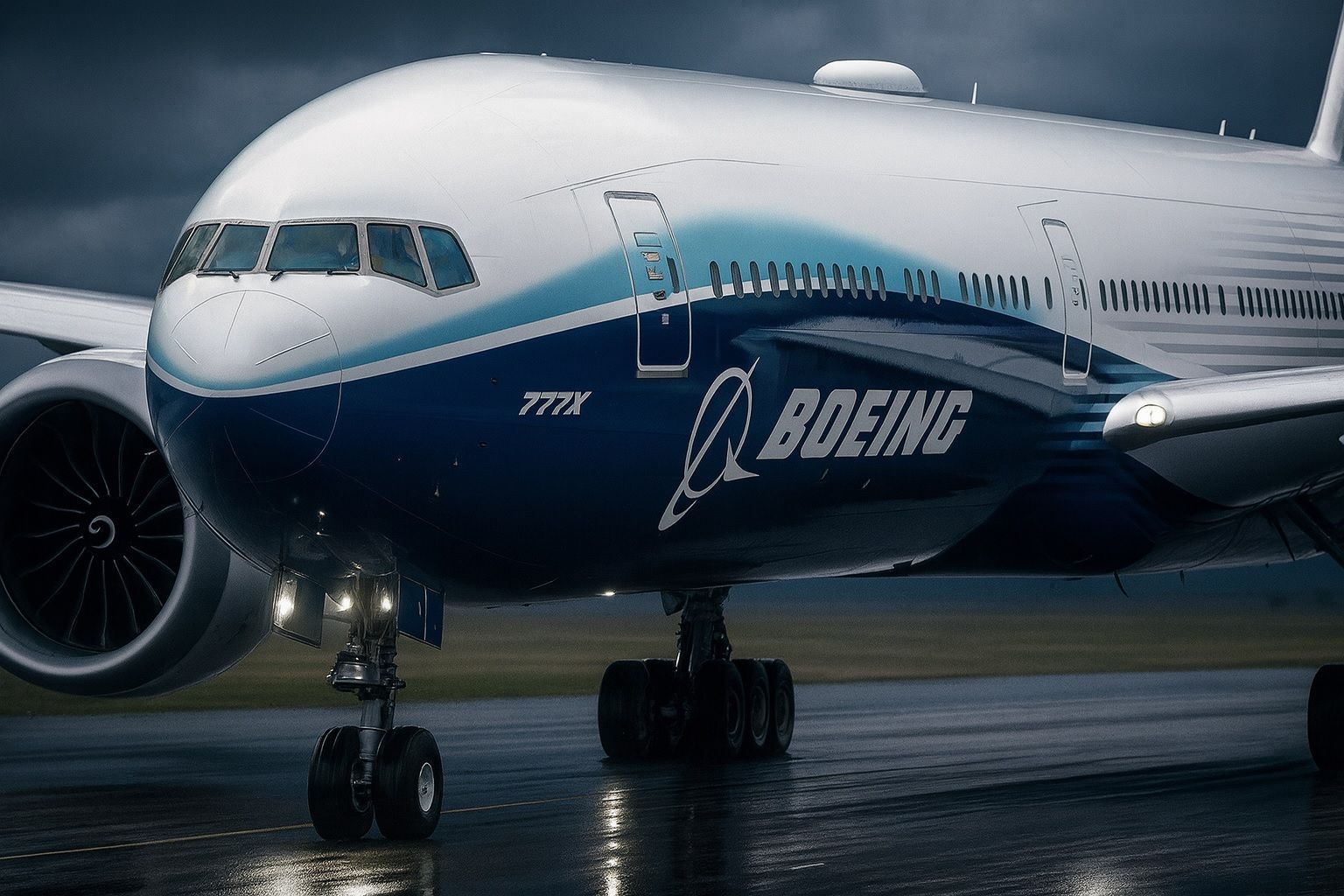- Stock price: About $213 per share as of the Oct. 17 close [1]. Boeing (BA) has traded roughly flat in recent sessions (near $210–$215). Over the past 12 months the shares have climbed roughly +45% [2], far outperforming the broader market.
- Orders & backlog: Boeing’s backlog is enormous (~$619 billion, ~5,900 aircraft [3]). Recent deals have been huge – for example, a late-September order for 75 Boeing 787 Dreamliners by Turkish Airlines (plus 150 additional 737 MAX options) [4], and up to 22 Dreamliners to Uzbekistan Airways (∼$8.5B) [5]. Boeing is also reportedly in talks to sell “as many as 500” jets to China [6]. These mega-orders have propped up Boeing’s outlook. Deliveries are ramping up (385 jets delivered by Aug. 2025 vs. 348 in all of 2024 [7]).
- Production & regulation: In mid-October the FAA raised Boeing’s 737 MAX production cap to 42 per month (from 38) [8], a key milestone enabling higher deliveries. Boeing’s CEO Kelly Ortberg notes the company won’t boost output until work on existing jets is finished – there’s still “a mountain of work” to certify its newest planes and even a “minor schedule delay” on the 777X can have a “pretty big financial impact” [9]. Boeing also faces regulatory scrutiny: an FAA probe into production issues is ongoing, and smaller MAX models (7 and 10) remain delayed [10]. In late Sep. the FAA partially restored Boeing’s own authority to self-certify 737/787 aircraft [11] (alternating weeks of FAA vs. Boeing reviews), which sent shares up ~5% on that news [12].
- Financial health: Boeing’s recent results show steady improvement. In Q2 2025, revenue surged ~35% year-on-year (to ~$22.8B) and the GAAP loss narrowed sharply (about $612M vs. $1.44B year-ago) [13]. Free cash flow roughly breakeven marked progress after heavy burns in prior years. However, Boeing still carries large debt (~$53.3B debt vs ~$23B cash [14]) and has not yet restored its dividend. Analysts highlight cash flow and debt reduction as key priorities.
- Analyst outlook: Wall Street is cautiously bullish. The consensus rating is roughly Moderate/Strong Buy [15], with an average 12-month target around the low $230s. Price targets range widely (~$140 on the low end up to $280+) [16], reflecting uncertainty. For instance, Bank of America reiterated a Buy with a $270 target [17], and Bernstein’s Douglas Harned recently maintained an Outperform rating and a $287 target [18]. Harned noted that Boeing has essentially completed a key production “rework” phase for the MAX, meaning one important bottleneck is cleared [19]. Conversely, bearish voices warn that fresh delays or safety setbacks could hurt BA sharply (some analysts say a drop toward the ~$120 range is possible in a worst-case turnaround failure [20]).
- Industry context: Boeing is a Dow 30 stock and sits at the heart of a booming aerospace & defense sector. The S&P Aerospace & Defense index is up about +44% YTD [21], driven by strong global travel demand and record defense budgets. The U.S. defense budget for 2025 is roughly $849 billion (with an additional ~$156 B in supplemental funding from a new budget act) [22]. That spending directly benefits major contractors like Boeing. Boeing competes with Airbus in commercial aviation – Airbus’s A320neo family has now surpassed Boeing’s 737 as the top-selling narrowbody [23] – and by August 2025 Airbus had delivered 434 jets vs. Boeing’s 385 [24]. In defense, Boeing is vying (alongside Northrop Grumman) for the U.S. Navy’s next-generation F/A-XX fighter [25]. TD Cowen analyst Roman Schweizer observes that selecting Boeing for that program would be “an important decision to keep pace” with China’s advanced fighter development [26]. All told, experts say Boeing’s stock is riding these industry tailwinds – but it must execute carefully.
Near-term forecasts: Analysts are watching Boeing’s progress closely. Many note that Boeing still has to clear remaining certification hurdles and manage its supply chain. Aerospace strategist Tony Bancroft (Gabelli Funds) calls Boeing a “long-term winner,” noting its robust backlog and improving controls [27]. Bernstein’s Harned expects Boeing to meet its year-end production goals now that rework is done [28]. S&P global analyst Ben Tsocanos (cited in 2024) said new liquidity measures were “prudent” given Boeing’s credit needs. Overall, market-watchers see Boeing’s stock as having room to run if deliveries and cash flow keep improving – but the company’s own caution is clear. As Ortberg put it, Boeing will be patient adding rate “a month at a time” if needed, because losing stability would be worse [29].
What analysts say: In aggregate, experts believe Boeing’s turnaround story is intact but still fragile. Bernstein’s Douglas Harned notes that completing the MAX production rework is “a key performance indicator” for Boeing’s recovery [30]. Barclays analyst David Strauss called the FAA’s recent production news “surprising” in how strongly it boosted the stock [31]. Trading Block strategist Michael Martin highlights the recent U.S. defense funding boost, saying it “creates a favorable environment” with opportunities from government contracts [32]. On the cautionary side, aerospace analyst Glenn McDonald points out that supply-chain issues remain “more sporadic and unpredictable” than before the pandemic [33], meaning Boeing must navigate these challenges carefully.
Outlook: Boeing will report its Q3 2025 earnings on October 29, which should offer fresh data on deliveries and production plans. Investors will be looking for signs that Boeing can sustain higher output and return to consistent profitability. In the near term, analysts see a fair amount of bullish momentum (and room for further stock gains if forecasts are met) – but the company’s performance hinges on controlling costs and avoiding mishaps. If Boeing executes as expected, most experts feel the stock still has upside; if new disruptions arise, however, they warn BA could quickly give back gains [34] [35].
Sources: Stock data and analyst commentary are drawn from recent market reports [36] [37] and industry news [38] [39]. The article also incorporates expert quotes and targets from financial and aerospace publications [40] [41] [42] [43]. (All stock prices and performance figures are as of mid-Oct. 2025.)
References
1. stockanalysis.com, 2. ts2.tech, 3. ts2.tech, 4. ts2.tech, 5. ts2.tech, 6. ts2.tech, 7. ts2.tech, 8. www.reuters.com, 9. www.reuters.com, 10. ts2.tech, 11. ts2.tech, 12. ts2.tech, 13. ts2.tech, 14. ts2.tech, 15. ts2.tech, 16. ts2.tech, 17. ts2.tech, 18. www.investing.com, 19. www.investing.com, 20. ts2.tech, 21. qz.com, 22. qz.com, 23. www.reuters.com, 24. ts2.tech, 25. www.reuters.com, 26. www.reuters.com, 27. qz.com, 28. www.investing.com, 29. www.reuters.com, 30. www.investing.com, 31. ts2.tech, 32. qz.com, 33. www.reuters.com, 34. www.reuters.com, 35. www.reuters.com, 36. stockanalysis.com, 37. ts2.tech, 38. www.reuters.com, 39. www.reuters.com, 40. www.reuters.com, 41. www.investing.com, 42. www.reuters.com, 43. qz.com







